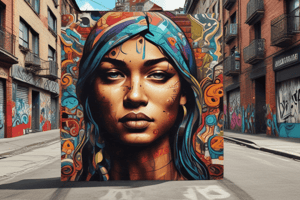Podcast
Questions and Answers
Who were the primary early graffiti writers in New York City in the 1960s and 1970s?
Who were the primary early graffiti writers in New York City in the 1960s and 1970s?
- Middle-aged Caucasian women
- Young Black and Latino men (correct)
- Elderly Asian individuals
- Teenagers from Europe
What inspired the early graffiti writers in New York City in the 1960s and 1970s?
What inspired the early graffiti writers in New York City in the 1960s and 1970s?
- Historical documentaries
- Comic books, cartoons, and Pop artists like Roy Lichtenstein (correct)
- Science fiction novels
- Nature magazines
Which style involved complex interlocking patterns in graffiti during the 1960s and 1970s?
Which style involved complex interlocking patterns in graffiti during the 1960s and 1970s?
- Tagging style
- Plainstyle
- Wildstyle (correct)
- Simplicity style
In which decades did graffiti become more mainstream and gain recognition as an art form?
In which decades did graffiti become more mainstream and gain recognition as an art form?
What is one of the aspects that graffiti is celebrated for today?
What is one of the aspects that graffiti is celebrated for today?
Flashcards are hidden until you start studying
Study Notes
History of Graffiti
Graffiti is a form of public street art that originated from ancient civilizations like Egypt. However, it gained significant popularity in the late 1960s when young people started using it as a mode of expression in the United States. Since its inception, graffiti has evolved into various styles and techniques, becoming a recognized global phenomenon.
Origin of Graffiti
The term "graffiti" comes from the Italian word 'graffiare', meaning to scratch or scrape. It was initially used by the Romans to describe any writing or drawing made by scratching on walls. Over time, graffiti became associated with public spaces and urban environments, often viewed as a form of vandalism due to its association with illegality and defacement.
Ancient Graffiti
Ancient Roman graffiti can still be seen today in Pompeii, where visitors can see images of everyday life drawn alongside more risqué content. Similarly, the Sahara Desert's Tassili n'Ajjer rock paintings show how early humans used graffiti in their daily lives. In these early instances, graffiti served as communication tools, records of events, and even as advertisements.
Medieval and Renaissance Era
During the Middle Ages, graffiti was primarily found on the walls of religious buildings, with the most common themes being prayers and requests for intercession. During the Renaissance, graffiti took on a new meaning as artists started using it as a form of self-expression.
Evolution of Graffiti
In the late 1960s and early 1970s, graffiti began to evolve from a simple form of vandalism to an art form. This transformation was largely driven by young people in New York City, who saw graffiti as a way to express their identity and culture.
Graffiti in the 1960s and 1970s
The early graffiti writers in New York City were primarily young Black and Latino men who drew their inspiration from comic books, cartoons, and the work of Pop artists like Roy Lichtenstein. They began to develop their own unique styles, such as wildstyle, which involved complex interlocking patterns, and tagging, a simple signature.
Graffiti in the 1980s and 1990s
In the 1980s and 1990s, graffiti became more mainstream, with artists gaining recognition for their work and being featured in exhibitions and galleries. This period also saw the rise of street art, which combined elements of graffiti with other artistic styles.
Graffiti Today
Today, graffiti is recognized as a legitimate form of art and is celebrated for its ability to transform urban spaces and engage communities. It continues to evolve, incorporating new technologies and techniques, and is practiced by artists around the world.
In conclusion, graffiti has a rich history that spans thousands of years and has evolved from a simple form of communication to a complex and diverse art form. It continues to shape public spaces and provoke thought and discussion, making it an integral part of our cultural landscape.
Studying That Suits You
Use AI to generate personalized quizzes and flashcards to suit your learning preferences.




